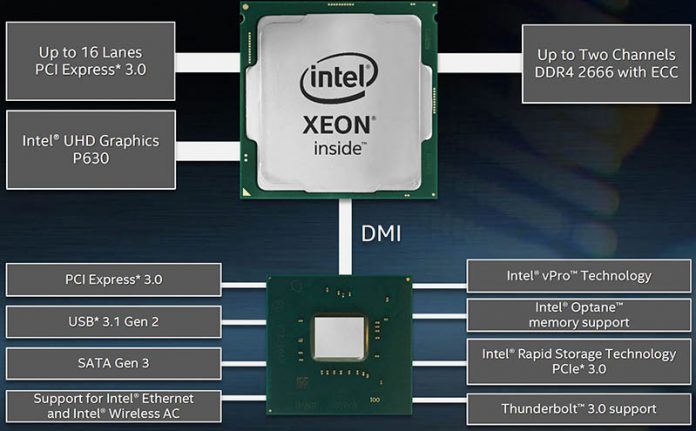With the Intel Xeon E-2100 series launch, there was a notable feeling that something was missing. The newly minted branding for Intel’s “entry” server and workstation offering had a higher-than-expected number of GPU offerings. We noted this in our Intel Xeon E-2100 Series Launch SKUs and Value Analysis piece. We also asked on the launch pre-briefing call and were told that the launch was focused on the workstation, not server CPUs. There seems to be an easy explanation: Intel is waiting for the 8-core parts to launch the server line.
Why 8-Core LGA 1151 Intel Xeon E Server SKUs
As we started going through our analysis in Looking back at Intel Xeon E3-1200 V1-V6 to the New Xeon E-2100 (a good read for anyone interested in this market), we noticed that what we are seeing may be more akin to the Intel Xeon E3-1200 V3 to V5 transition where Intel has skipped a server CPU generation.
Over the past few days, we have been confirming our suspicions. There will be 8-core Intel Xeon E “entry” level SKUs launching in the same LGA1151 platforms that launched with the Xeon E-2100 series.
This makes sense. We know that on the consumer side, an 8-core “AMD Ryzen killer” part is coming. Intel needs to move its low-end desktop line to 8 cores to match what AMD is offering. We expect that generation of desktop parts to launch by Q4 of 2018 at the latest. Intel Xeon E3-1200, E3-1500 and now E-2100 launches have all trailed their desktop counterpart launches by several months. Still, without server chips in the segment, the entire line will get distorted.
We also expect by the end of Q4 that these supported 8-core models in the entry-level Xeon line are coming. Still, it follows the standard operating procedure for Intel so if and when we see an 8 core Coffee Lake refresh chip on the desktop, we will see an update to the Intel Xeon E line accordingly.
Final Words
This has now been confirmed by three industry sources although Intel did not confirm an unannounced product. For the entry-level Xeon space, this will be the most exciting launch since the 2009 Lynnfield X3400 generation. We do not expect the 8-core chips to launch in Q3, and likely it will be sometime after they launch on the desktop. The batch of Dell, HP, ASUS and other Intel Xeon E-2100 workstations should be upgradable to the new 8-core Xeon LGA1151 CPUs.





Its a shame that Intel still is nerfing this platform (E3/E-2100), sure, obviously they need to differentiate between all of the Xeon platforms but didn’t they go a little bit to far? Still only 64GB ram? (even Atom CPU:s can do 256GB). No built in 10Gbit ethernet, still…even some Atom SKU:s have up to 4 10Gbit ports. Very few PCI lanes, etc etc etc.
256GB RAM, 8 cores, 40 PCI lanes (or atleast 32 on CPU for 2 16x GPU:s or other accelerators + some more lanes on chipset) and 2 10Gbit ethernet and this platform would be amazing. So congratulations Intel, you forced me to look at Xeon Scalable for my needs instead (which i won’t do, time to look at AMD in the future instead since they are way more generous)
I agree with JesperA
I would consider 128GB to be an absolute minimum (4x 32GB modules). The 64GB limit simply pushes me to AMD P series single socket for small servers, as its much better value than the Xeon Scalable Bronze/Silver Intel is trying to force me to buy.
The same story for workstations, Threadripper is significantly more flexible and powerful. And Ryzen 7 Pro is significantly cheaper for nearly the same performance.
Or Threadripper 1900X with 128 GB ECC UDIMM (8x16GB) with 60+4 PCIe lanes for only $300 on Newegg today.
Some of these comments are by people who don’t get the market. These chips are basically just server-ized desktop parts that aren’t meant to have gobs of memory capacity & PCI express support.
AMD does the exact same thing with desktop RyZen parts that don’t support more than 64 GB of RAM and don’t provide any extra PCIe lanes and nobody seems to post canned complaints about them.
If you want a Xeon Bronze or silver then go for it, but not everybody needs that and these chips sell quite well.
The Zen memory controller supports 512 GB per die.
We can only guess the reasons why the Ryzen cpu’s are limited to 64 GB and the Threadripper are limited to 128 GB.
@Misha the various Zen (and Intel) memory limitations are easily explained by the current maximum memory channels and DIMM sizes.
Ryzen / Xeon E2100 4 channels, DDR4 unregistered is 4x16Gb max
Threadripper 8 channels DDR4 unregister hence 8x16Gb max memory
Xeon D / Xeon W / Epyc / Xeon Scalable all either support registered DIMM or LRDIMM to achieve higher memory density per chip
I expect 32Gb unregistered memory in late 2018 / early 2019 as Samsung’s quarterly forecast suggest, which may up the limit for consumer grade chips to double the current capacity
@David
Zen dies memory controllers can handle 512 GB over 2 channels
Ryzen has 1 die and 2 channels per die hence 512 GB.
TR has 2 dies and 2 channels per die hence 1024 GB.
EPYC has 4 dies and 2 channels per die hence 2048 GB.
Ryzen could work perfectly with 4 x 128 GB Registered DIMM 288pin.
The limitation is not the Zen die but the motherboard.
@Misha the memory support is determined by the motherboard chipset which is also provided by AMD, you cannot separate the chipset and Zen dies as they’re linked by microcode support and physical pin layout.
Zen is SoC